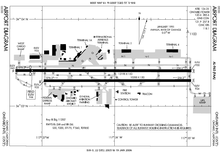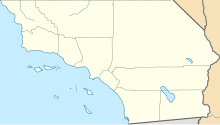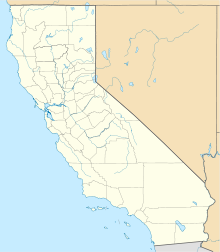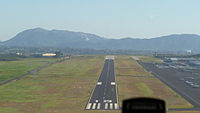avia.wikisort.org - Aerodrome
Ontario International Airport (IATA: ONT, ICAO: KONT, FAA LID: ONT) is an international airport two miles east of downtown Ontario, in San Bernardino County, California, United States, about 38 mi (61 km) east of downtown Los Angeles and 18 mi (29 km) west of downtown San Bernardino. It is owned and operated under a joint-powers agreement with the city of Ontario and San Bernardino County.[1]
Ontario International Airport | |||||||||||||||
|---|---|---|---|---|---|---|---|---|---|---|---|---|---|---|---|
 | |||||||||||||||
| |||||||||||||||
| Summary | |||||||||||||||
| Airport type | Public | ||||||||||||||
| Owner/Operator | Ontario International Airport Authority[1] | ||||||||||||||
| Serves | San Bernardino/Riverside Greater Los Angeles | ||||||||||||||
| Location | Ontario, California | ||||||||||||||
| Hub for | |||||||||||||||
| Focus city for | Amazon Air | ||||||||||||||
| Elevation AMSL | 944 ft / 288 m | ||||||||||||||
| Coordinates | 34°03′22″N 117°36′04″W | ||||||||||||||
| Website | flyontario | ||||||||||||||
| Maps | |||||||||||||||
 FAA airport diagram | |||||||||||||||
 ONT Location in the Los Angeles metropolitan area  ONT Location in Southern California  ONT Location in California  ONT Location in the United States | |||||||||||||||
| Runways | |||||||||||||||
| |||||||||||||||
| Statistics (2021) | |||||||||||||||
| |||||||||||||||
The airport covers 1,741 acres (705 ha) and has two parallel runways.[2][4] It is the West Coast air and truck hub for UPS Airlines and is a major distribution point for FedEx Express. As of September 2018[update], ONT has more than 64 daily departures and arrivals.[5] As Ontario's long runways (runway 8L/26R) are longer than three of the four runways at Los Angeles International Airport (LAX), it is an alternate landing site for large aircraft destined for LAX.[6]
History
Origins
In 1923, a landing field was established east of Central Avenue (3 mi (4.8 km) west of the current airport) on land leased from the Union Pacific Railroad. The airfield was named Latimer Field after an orange-packing company next to the airstrip. An airport was built there by one of the first flying clubs in Southern California, the Friends of Ontario Airport. In 1929, the city of Ontario purchased 30 acres (12 ha), now in the southwest corner of the airport, for $12,000 (equivalent to $189,000 in 2021),[7] and established the Ontario Municipal Airport.
In 1941, the city bought 470 acres (190 ha) around the airport and approved construction of new runways, which were completed by 1942, with funds from the Works Progress Administration. The 6,200 ft (1,900 m) east–west runway and the 4,700 ft (1,400 m) northeast–southwest runway cost $350,000 (equivalent to $5,800,000 in 2021).[8] On 27 February 1942, an Army Air Corps plane made the first landing at the new airport. By 1943, the airport was an Army Air Corps Lockheed P-38 Lightning training base and North American P-51 Mustang operating base.
After the war, it was one of the five large storage, sales, and scrapping centers for Army Air Forces aircraft established by the Reconstruction Finance Corporation; others were at Albuquerque AAF, New Mexico; Altus AAF, Oklahoma; Kingman AAF, Arizona; and Walnut Ridge AAF, Arkansas.
Ontario International Airport

In 1946, Ontario Municipal Airport was renamed "Ontario International Airport" because of the trans-Pacific cargo flights originating there. On 17 May 1946, two Army surplus steel hangars arrived at the airport, which the Ontario city council had authorized the $50,000 purchase of just the previous week. City officials were pleased to have secured a bargain. Thought to be the only pair available in the U.S., City Manager Harold J. Martin observed that even if they could be acquired at a later date, the cost would be several times that afforded by prompt action.[9] A Pacific Overseas Airlines flight from Shanghai arrived at Ontario on 18 May 1946, "which inaugurated regular round-trip air passenger air service between the United States and the Orient."[10] In 1949, Western Airlines began scheduled flights; in 1955, Bonanza Air Lines flights started. Western and Bonanza nonstops did not reach beyond Las Vegas. In 1962, Western began nonstop flights to San Francisco (one Electra daily). In 1967, Bonanza began nonstop F27 flights to Phoenix.
Ontario and Los Angeles entered into a joint-powers agreement, making Ontario International Airport part of the Los Angeles regional airports system in 1967.[11] In 1968, the airport had its first scheduled jet flights. In 1969, Continental Airlines started Boeing 720B nonstops to Denver and Chicago; Air California started Boeing 737 flights to San Jose; Pacific Southwest Airlines started San Francisco flights; and Western began 737 nonstops to Sacramento and Salt Lake City. In 1970, United Airlines started a nonstop to Chicago and American started flights to Dallas (and Chicago, for a short time). In September 1986, Ontario hosted the Concorde supersonic airliner during a promotional round-the-world flight.[12]
In 1981, a second east–west runway, 26L/8R, was built, necessitating the removal of the old NE-SW runway 4/22. Remnants of the 4/22 runway are visible in the present-day taxiways. With the completion of the new runway, the existing runway 25/7 became 26R/8L. In 1985, the city of Los Angeles acquired Ontario International Airport outright from the city of Ontario. In 1987, Runway 26R/8L was extended to the east to bring the two runway thresholds side by side, so aircraft would be higher over neighborhoods. 26R/8L became the main departing runway and 26L/8R the main arrival runway.
For a number of years, the airport operated alongside Ontario Air National Guard Station, which was closed as a result of the 1995 Base Realignment and Closure Commission.
In 1998, the new and larger airport terminal opened, designed by DMJM Aviation.[13] Two older terminals, west of the current terminal, the main terminal and a small terminal were discontinued when the new Terminal 2 and Terminal 4 facilities were opened. The old terminals currently house the administration and the USO.
In 2005 and 2006, runway 26R/8L was repaved and strengthened, and received storm drains and better runway lighting, and additional improvements to taxiway intersections were made.[14]
In 2006, Ontario International Airport became "LA/Ontario International Airport." The "LA" portion was added to remind fliers of Los Angeles and to avoid confusion with the province of Ontario in Canada.[15]

The airport's traffic peaked in 2005 with 7.2 million passengers, and remained steady through 2007. Around the time of the 2008 financial crisis, JetBlue suspended service to ONT, and major legacy carriers significantly decreased their passenger volume at the airport.[16] Southwest Airlines transferred a significant portion of its Ontario capacity to Los Angeles International Airport (LAX), making LAX fares more competitive with ONT, while being coupled with more attractive frequencies and a wider range of destinations. The surrounding Inland Empire region was hit hard by the financial crisis, with the nearby city of San Bernardino declaring bankruptcy.[17] The airport suffered a 40% decline in traffic between 2007 and 2012,[18] during which time traffic at LAX recovered to surpass prerecession levels.[16]
Ontario International Airport Authority
Ownership and control of the airport became an issue in late 2010, when the city of Ontario, supported by the Southern California Association of Governments, criticized and questioned LAWA's operation of the airport.[19][20][21] A group of local government officials, led by Ontario city council member Alan Wapner, began a campaign to transfer control of the airport away from Los Angeles World Airports. Wapner argued that the City of Los Angeles had no interest in maintaining service at an airport well beyond its borders.[17] In 2013, LAWA offered to return the airport to local control for a purchase price of $474M, which was rejected.[22] Local groups then sued the city of Los Angeles, a suit that was temporarily suspended when both sides agreed to attempt to work together.[23]
In 2015, Los Angeles World Airports tentatively agreed to turn over ownership of Ontario Airport to the city of Ontario. LAWA was "to be reimbursed for its investments in the facility, job protection for the facility's 182 employees and the settlement of a lawsuit in which Ontario sought to regain control of the airport. Once ownership is transferred, the airport will be operated by the Ontario International Airport Authority, formed under a joint-powers agreement between the city of Ontario and San Bernardino County." The Ontario International Airport Authority took over control of operations in November 2016, and the airport's operating name was reverted to Ontario International Airport, since the City of Los Angeles no longer oversaw operations of the airport.[5][24]
The airport's continuing traffic decline reversed in early 2017, when the airport experienced faster growth than LAX for the first time since 2007.[25] On September 30, 2017, it was announced that China Airlines would begin nonstop flights from Ontario to Taipei, which started in spring 2018.[26][27]
Facilities


Terminals
Ontario International Airport has two terminals with 27 gates and a separate adjacent international arrivals facility with 2 arrival-only gates, totaling 29 gates.[28]
Terminal 2 has 265,000 sq ft (24,600 m2) and 13 gates.[29]
Terminal 4 has 265,000 sq ft (24,600 m2) and 14 gates.[30]
The international arrivals facility has two gates for arrivals only, containing the airport's U.S. Customs and Border Protection facility.[31] International flights depart from the main terminals.
A USO is housed in the old terminal complex near the international arrivals facility.[32]
Remote parking is located on the east end of the airport (moved from its former location at the west end). On the east end is a ground transportation center that consolidates the rental car companies in one central location. A bus circles the airport and provides connections to each of the terminals, rental car and remote parking lots, and public transit stops.
General aviation is located at the south side of the airport, although most general-aviation pilots tend to use a number of nearby airports: Redlands Airport, Chino Airport, Brackett Field in La Verne, Cable Airport in Upland, or San Bernardino International Airport.
Ground transportation
The airport is located about 38 miles (61 km) east of downtown Los Angeles, 18 miles (29 km) west of downtown San Bernardino, and 14 miles (23 km) northwest of downtown Riverside. Motorists can use the San Bernardino Freeway (Interstate 10), Ontario Freeway (Interstate 15), or the Pomona Freeway (State Route 60).
Omnitrans, San Bernadino County's main public transportation agency, operates three routes near the airport.[33] Route 380, also called ONT Connect, provides non-stop service every 35 to 60 minutes between the airport and Rancho Cucamonga station,[34] where passengers can connect to Metrolink's San Bernardino Line, which operates daily with service to Los Angeles Union Station. Route 61 operates daily between Downtown Pomona station, the airport and Fontana station, Both routes 61 and 380 operate from stops located east of baggage claim at terminals 2 and 4. Route 81 operates Monday through Saturday on Haven Avenue which runs along the eastern edge of the airport between Chaffey College and Ontario–East station, where passengers can connect to Metrolink's Riverside Line, which operates during weekday peak periods.
Noise restrictions
Ontario has few noise restrictions/abatement rules, unlike other Southern California airports such as John Wayne Airport, Bob Hope Airport, Long Beach Airport, and San Diego International Airport, which all have very strict policies.[35] The airport is allowed to operate 24/7, but during the hours of 10 pm to 7 am, all aircraft must arrive from the east on runway 26L or 26R and take off to the east on runway 8R or 8L, depending on ATC instruction. This procedure is known as "Contra-Flow" operations and applies to turbojet or turbofan aircraft. This procedure is similar to the one employed by LAX, where all landings are conducted from the east and all takeoffs are to the west (known as "over-ocean" operations) between midnight and 6:30 am. Both of these procedures are employed as long as weather and/or construction activity permits. This is done in an effort to be better neighbors and minimize the noise impact to the surrounding communities as much as possible. Residents of cities west of the airport have complained of increased noise as a result of the airport's refusal to abide by noise abatement rules.[36]
Airlines and destinations
Passenger
| Airlines | Destinations | Refs |
|---|---|---|
| Alaska Airlines | Portland (OR), Seattle/Tacoma | [37] |
| American Airlines | Charlotte, Dallas/Fort Worth, Phoenix–Sky Harbor | [37] |
| American Eagle | Phoenix–Sky Harbor | [37] |
| Avianca El Salvador | San Salvador | [37] |
| China Airlines | Taipei–Taoyuan | [37] |
| Delta Air Lines | Atlanta, Salt Lake City, Seattle/Tacoma[38] | [37] |
| Delta Connection | Salt Lake City | [37] |
| Frontier Airlines | Atlanta, Chicago–Midway, Denver, Las Vegas, Orlando, Phoenix–Sky Harbor, Sacramento, San Francisco Seasonal: Dallas/Fort Worth | [37] |
| Hawaiian Airlines | Honolulu | [37] |
| JetBlue | New York–JFK | [37] |
| Southwest Airlines | Austin, Chicago–Midway, Dallas–Love, Denver, Houston–Hobby, Las Vegas, Oakland, Phoenix–Sky Harbor, Sacramento, San Jose (CA) Seasonal: Salt Lake City[39] | [37] |
| United Airlines | Denver, San Francisco Seasonal: Houston–Intercontinental | [37] |
| United Express | Denver, Houston–Intercontinental, San Francisco | [37] |
| Volaris | Guadalajara | [37] |
Cargo





Statistics
Top destinations
| Rank | Airport | Passengers | Carriers |
|---|---|---|---|
| 1 | Dallas/Fort Worth, Texas | 318,000 | American, Frontier |
| 2 | Denver, Colorado | 288,000 | Frontier, Southwest, United |
| 3 | Phoenix–Sky Harbor, Arizona | 280,000 | American, Frontier, Southwest |
| 4 | Seattle/Tacoma, Washington | 238,000 | Alaska, Delta |
| 5 | Las Vegas, Nevada | 231,000 | Frontier, Southwest |
| 6 | Sacramento, California | 203,000 | Frontier, Southwest |
| 7 | Oakland, California | 165,000 | Southwest |
| 8 | Atlanta, Georgia | 147,000 | Delta, Frontier |
| 9 | Salt Lake City, Utah | 136,000 | Delta |
| 10 | San Jose, California | 134,000 | Southwest |
| Rank | Airport | Passengers | Carriers |
|---|---|---|---|
| 1 | Guadalajara, Mexico | 88,210 | Volaris |
| 2 | San Salvador, El Salvador | 17,591 | Avianca |
| 3 | Mexico City, Mexico | 15,419 | Volaris |
| 4 | Taipei–Taoyuan, Taiwan | 2,114 | China Airlines |
Airline market share
| Rank | Airline | Passengers | Share |
|---|---|---|---|
| 1 | Southwest Airlines | 2,197,000 | 41.76% |
| 2 | American Airlines | 796,000 | 14.95% |
| 3 | Frontier Airlines | 551,000 | 10.34% |
| 4 | Delta Airlines | 440,000 | 8.24% |
| 5 | Alaska Airlines | 415,000 | 7.80% |
Annual traffic
| Year | Passengers | Year | Passengers | Year | Passengers |
|---|---|---|---|---|---|
| 1992 | 6,121,623 | 2002 | 6,516,858 | 2012 | 4,318,994 |
| 1993 | 6,192,035 | 2003 | 6,547,877 | 2013 | 3,969,974 |
| 1994 | 6,386,000 | 2004 | 6,937,337 | 2014 | 4,127,278 |
| 1995 | 6,405,097 | 2005 | 7,213,528 | 2015 | 4,209,311 |
| 1996 | 6,252,838 | 2006 | 7,049,904 | 2016 | 4,217,366 |
| 1997 | 6,300,862 | 2007 | 7,207,150 | 2017 | 4,552,225 |
| 1998 | 6,434,858 | 2008 | 6,232,761 | 2018 | 5,115,894 |
| 1999 | 6,578,005 | 2009 | 4,886,695 | 2019 | 5,583,732 |
| 2000 | 6,756,086 | 2010 | 4,808,241 | 2020 | 2,538,482 |
| 2001 | 6,702,400 | 2011 | 4,551,875 | 2021 | 4,496,592 |
Accidents and incidents
- On December 25, 1945, a USAAF Douglas C-47 was stolen by two non-pilot ground members. It crashed four miles east of the airport, killing both occupants.[52]
- On March 31, 1971, Western Airlines Flight 366, a Boeing 720 on a training flight, crashed on approach to Ontario during a three-engine ILS approach in limited visibility due to a loss of left rudder control. All five occupants on board were killed.[53]
- On January 9, 1975, Golden West Airlines Flight 261, a De Havilland Twin Otter DHC-6 en route to Los Angeles collided with a Cessna 150 near Whittier. Four crew and twelve passengers on the two aircraft were killed.[54]
References
- "About | Ontario International Airport Authority". Archived from the original on October 11, 2016. Retrieved October 1, 2016.
- FAA Airport Form 5010 for ONT PDF, effective December 30, 2021
- "Statistics". Ontario International Airport. January 2017. Retrieved January 30, 2017.
- "ONT airport data at skyvector.com". skyvector.com. Retrieved August 24, 2022.
- "Airport Information - Ontario International Airport". Flyontario.com. Retrieved September 29, 2018.
- "Overseas flights diverted to Ontario Airport due to fog". February 5, 2015. Retrieved August 8, 2020.
- 1634–1699: McCusker, J. J. (1997). How Much Is That in Real Money? A Historical Price Index for Use as a Deflator of Money Values in the Economy of the United States: Addenda et Corrigenda (PDF). American Antiquarian Society. 1700–1799: McCusker, J. J. (1992). How Much Is That in Real Money? A Historical Price Index for Use as a Deflator of Money Values in the Economy of the United States (PDF). American Antiquarian Society. 1800–present: Federal Reserve Bank of Minneapolis. "Consumer Price Index (estimate) 1800–". Retrieved April 16, 2022.
- "Ontario Air National Guard Station". California State Military Museum. Retrieved February 18, 2013.
- "Ontario Acquires Plane Hangars", The San Bernardino Daily Sun, San Bernardino, California, Saturday 18 May 1946, Volume 52, page 3.
- Associated Press, The San Bernardino Daily Sun, San Bernardino, California, Sunday 19 May 1946, page 8.
- Q&A LA/Ontario International Airport (PDF) (Report). Los Angeles World Airports. July 1, 2015. p. 2. Archived from the original (PDF) on November 4, 2016. Retrieved November 1, 2016.
- "Concorde Arrives at Ontario--5 Hours Late". Los Angeles Times. September 22, 1986. ISSN 0458-3035. Retrieved January 17, 2017.
- "Architectural Glass Design". Aecinfo.com. Archived from the original on March 16, 2005. Retrieved September 29, 2018.
- "Ontario International Airport Runway Construction Project To Begin". April 26, 2005. Retrieved November 2, 2016.
- "Passenger growth at Ontario airport stagnant - Business - PE.com - Southern California News - News for Inland Southern California". Pe.com. Retrieved September 29, 2018.
- "Inland Empire Outlook: Challenges Remain for ONT | The Rose Institute of State and Local Government". Roseinstitute.org. Retrieved September 19, 2018.
- Witz, Billy (September 2, 2013). "Recession Reverses California Airport's Growth". The New York Times. Retrieved September 19, 2018.
- "Report Warns of Steep Traffic Decline at Ontario Airport". KTLA. August 5, 2013. Retrieved September 19, 2018.
- "Locals Want to Run Ontario Airport". Nbclosangeles.com. Retrieved September 29, 2018.
- "Ontario: L.A. should relinquish control of Ontario Airport, Daily Breeze". Dailybreeze.com. Archived from the original on March 7, 2012. Retrieved September 29, 2018.
- "Regional support for Inland control of Ontario airport, The BizPress". Inlandsocal.com. Archived from the original on July 13, 2011. Retrieved September 29, 2018.
- "Ontario rejects $474 million offer for airport". Dailybulletin.com. April 11, 2013. Retrieved September 29, 2018.
- "Los Angeles should work with Ontario on L.A./Ontario International Airport, Sen. Dianne Feinstein says". Dailybreeze.com. December 19, 2013. Retrieved September 29, 2018.
- Weikel, Dan (November 2, 2016). "Ontario officials get ownership of international airport and pledge more flights and services - Los Angeles Times". Los Angeles Times. Retrieved September 29, 2018.
- "What the latest passenger numbers at Ontario airport did in March that they haven't done in a decade". Daily Bulletin. April 28, 2017. Retrieved September 19, 2018.
- Scauzillo, Steve (November 9, 2019). "After 3 years of local control, Ontario airport has more passengers but transit options remain iffy". Daily Bulletin. Retrieved February 21, 2021.
- "China Airlines announces nonstop weekly flights to Ontario airport in Spring 2018". Archived from the original on October 4, 2017. Retrieved October 3, 2017.
- "Airport Overview - Ontario International Airport". Flyontario.com. Retrieved September 29, 2018.
- "Terminal 2 Map". Retrieved August 8, 2020.
- "Terminal 4 Map". Retrieved August 8, 2020.
- "ONTARIO AIRPORT INTERNATIONAL ARRIVALS FACILITY". Retrieved August 8, 2020.
- "Bob Hope USO Ontario - The Bob Hope USO". Bobhopeuso.org. Retrieved September 29, 2018.
- "Omnitrans" (PDF) (Map). Omnitrans. August 8, 2022. Retrieved October 16, 2022.
- "ONT Connect, Route 380". Omnitrans. August 8, 2022. Retrieved October 16, 2022.
- "Noise Management - Ontario International Airport". Flyontario.com. Retrieved September 29, 2018.
- Dunkle, Brenda. "Meeting Sunday on Ontario International Airport noise". Champion Newspapers. Retrieved November 14, 2019.
- "Nonstop Destinations". flyontario.com. Retrieved March 28, 2019.
- "Delta Adds A220 Seattle – Ontario Service From Nov 2022". Aeroroutes. Retrieved October 26, 2022.
- https://wieck-swa-production.s3.amazonaws.com/NovemberBaseScheduleExtension.pdf [bare URL PDF]
- "Aloha Cargo 710 ✈ FlightAware". Flightaware.com. Retrieved July 4, 2020.
- "Sun Country Airlines 3041 ✈ FlightAware". Flightaware.com. Retrieved November 14, 2020.
- "Atlas Air 3527 ✈ FlightAware". Flightaware.com. Retrieved September 2, 2019.
- "ABX Air 3407 ✈ FlightAware". Flightaware.com. Retrieved September 2, 2019.
- "Kalitta Air 2014 ✈ FlightAware". Flightaware.com. Retrieved December 5, 2018.
- "United Parcel Service 2770 ✈ FlightAware". Flightaware.com. Retrieved July 4, 2020.
- "United Parcel Service 2274 ✈ FlightAware". Flightaware.com. Retrieved February 19, 2020.
- "RITA | BTS | Transtats". Transtats.bts.gov. Retrieved March 11, 2021.
- "Ontario International Airport Calendar December and YTD" (PDF). flyontario.com. Retrieved February 16, 2022.
- "Estadística operacional por origen-destino / Traffic Statistics by City Pairs". gob.mx. Retrieved February 16, 2022.
- "Ontario International Airport PAX and Cargo Statistics". flyontario.com. October 27, 2016. Retrieved January 14, 2020.
- "ONTARIO: Airport passenger, cargo volumes climbed in 2015". Pe.com. January 26, 2016. Retrieved September 29, 2018.
- Accident description for 43-48315 at the Aviation Safety Network
- Accident description for N3166 at the Aviation Safety Network
- Accident description for N6383 at the Aviation Safety Network
External links
- Official Ontario International Airport website
- Ontario International Airport Master Plan
- openNav: ONT / KONT charts
- Weikel, Dan. "Los Angeles Times: "As use dwindles, calls grow for local control of Ontario airport" — 31 October 2011 article
- FAA Airport Diagram (PDF), effective November 3, 2022
- Resources for this airport:
- AirNav airport information for KONT
- ASN accident history for ONT
- FlightAware airport information and live flight tracker
- NOAA/NWS weather observations: current, past three days
- SkyVector aeronautical chart for KONT
- FAA current ONT delay information
На других языках
[de] Ontario International Airport
Der Ontario International Airport (IATA: ONT, ICAO: KONT) ist ein Verkehrsflughafen ist der internationale Verkehrsflughafen der amerikanischen Großstadt Ontario im US-Bundesstaat Kalifornien.- [en] Ontario International Airport
[es] Aeropuerto Internacional LA/Ontario
El Aeropuerto Internacional LA/Ontario (en inglés: LA/Ontario International Airport) (IATA: ONT, OACI: KONT, FAA LID: ONT), (anteriormente como Aeropuerto Internacional de Ontario) es un aeropuerto público localizado a dos millas (3 km) al este del Distrito Financiero Central (CBD) de Ontario, una ciudad en el condado de San Bernardino, California, Estados Unidos. Este aeropuerto es operado y propiedad de Los Ángeles World Airports, una agencia de la Ciudad de Los Ángeles. En 2008, 6.2 millones de pasajeros usaron el aeropuerto, un declive del 13.5 % comparado al 2007.[3][fr] Aéroport international d'Ontario
L'aéroport international d'Ontario (code IATA : ONT • code OACI : KONT) est situé dans la ville du même nom, dans l'État de Californie, aux États-Unis.[it] Aeroporto Internazionale di Ontario
L'Aeroporto Internazionale di Ontario, anche Aeroporto Internazionale di Los Angeles-Ontario (in inglese: LA/Ontario International Airport) (IATA: ONT, ICAO: KONT) è un aeroporto statunitense situato a 3,7 km dal centro di Ontario, nello Stato della California.Другой контент может иметь иную лицензию. Перед использованием материалов сайта WikiSort.org внимательно изучите правила лицензирования конкретных элементов наполнения сайта.
WikiSort.org - проект по пересортировке и дополнению контента Википедии
